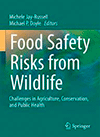A European perspective on the transmission of food-borne pathogens at the wildlife-livestock-human interface
The book Food Safety Risks from wildlife: Challenges in Agriculture, Conservation and Public Health edited by Springer International Publishing includes this chapter
January 1st, 2016
Navarro-Gonzalez N., Ugarte-Ruiz M., Dominguez L. and Ruiz-Fons F.
There are many unique aspects and peculiarities regarding the transmission of foodborne pathogens at the wildlife–livestock–human interface in Europe, which include the diversity of farming systems, wildlife and habitats, as well as the consumption habits of the European human population. However, it can be generalized that zoonotic diseases acquired from wildlife (or directly related to wildlife) are mainly linked to the consumption of undercooked venison, hunting or handling infected game carcasses. Hunting has always been an integral part of the cultures and traditions of European rural societies, with an estimated greater than seven million hunters practicing this activity for recreational, social, and/or consumptive purposes (Brainerd, http://fp7hunt.net/Portals/HUNT/Hunting_Charter.pdf , 2007). Recently, there has been a growing consumer demand for hunted meat and cured, fermented, and dried game products, which have become more popular and accessible in the European market (Cenci-Goga et al., Meat Sci 90:599–606, 2012; Obwegeser et al., Vet Micro 159:149–154, 2012). Schulp et al. (Ecol Econ 105:292–305, 2014) report that 38 of the 97 European game species, including birds and mammals, are consumed, with the red deer (Cervus elaphus), the roe deer (Capreolus capreolus), the European hare (Lepus europaeus), the common pheasant (Phasianus colchicus), and the wild boar (Sus scrofa) being the main game food species, since they are hunted in all countries and have the largest harvest numbers. Considerable research has been conducted on foodborne pathogens in the most common wild ungulate species in several European countries; however, relatively little information is available on hares and other lagomorphs, as well as wild game birds
| Servicio de Ecopatología de Fauna Salvaje (SEFaS). Universitat Autònoma de Barcelona (UAB). 111 | |
 | Servicio de Zoonosis de Transmisión Alimentaria y Resistencia a Antimicrobianos (ZTA). Centro de Vigilancia Sanitaria Veterinaria (VISAVET). Universidad Complutense (UCM). 111 |
| Sanidad y Biotecnología (SaBio). Instituto de Investigación en Recursos Cinegéticos (IREC). Consejo Superior de Investigaciones Científicas (CSIC). Universidad de Castilla La Mancha (UCLM). Gobierno de Castilla-La Mancha (JCCM). 111 | |

